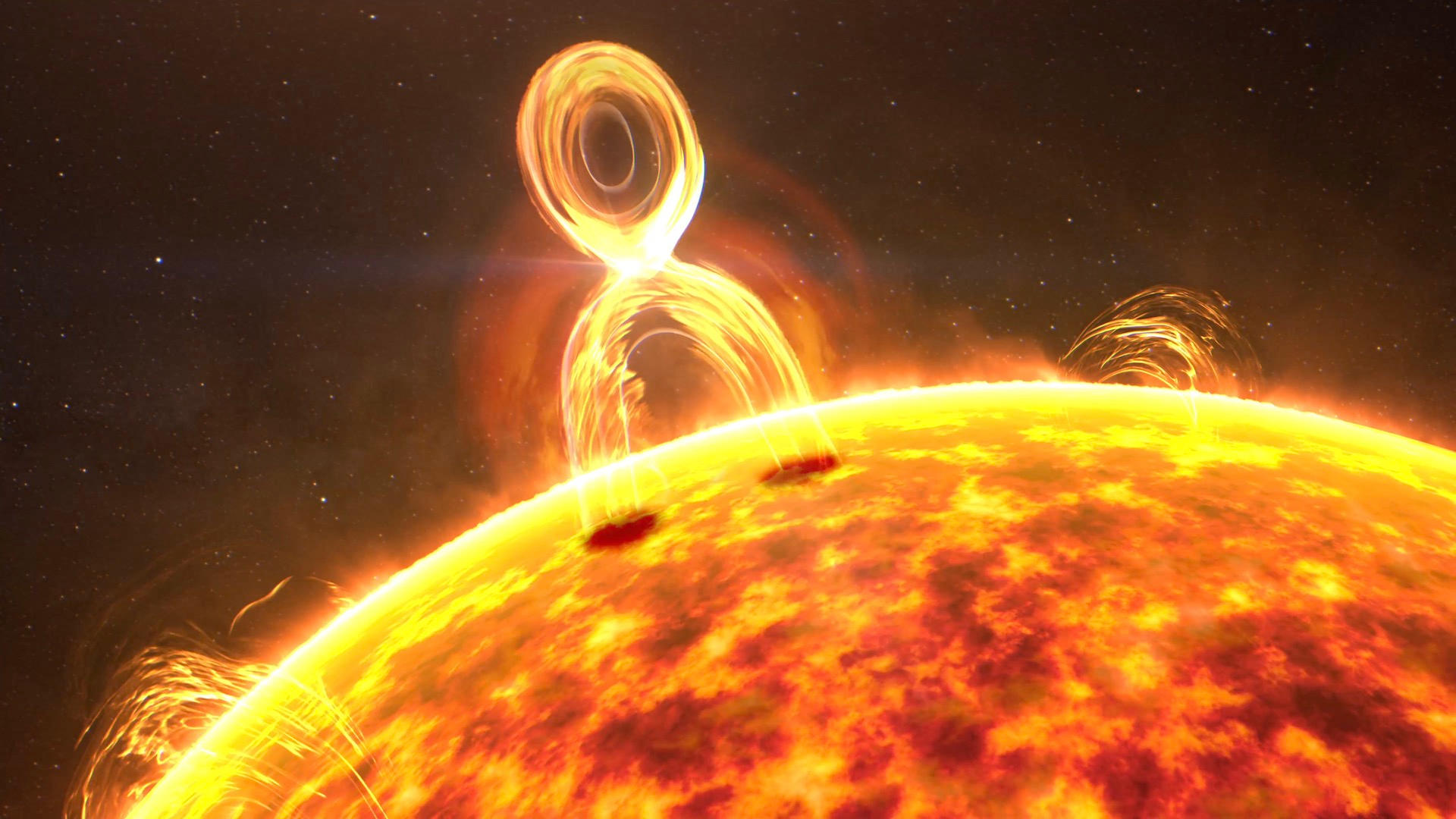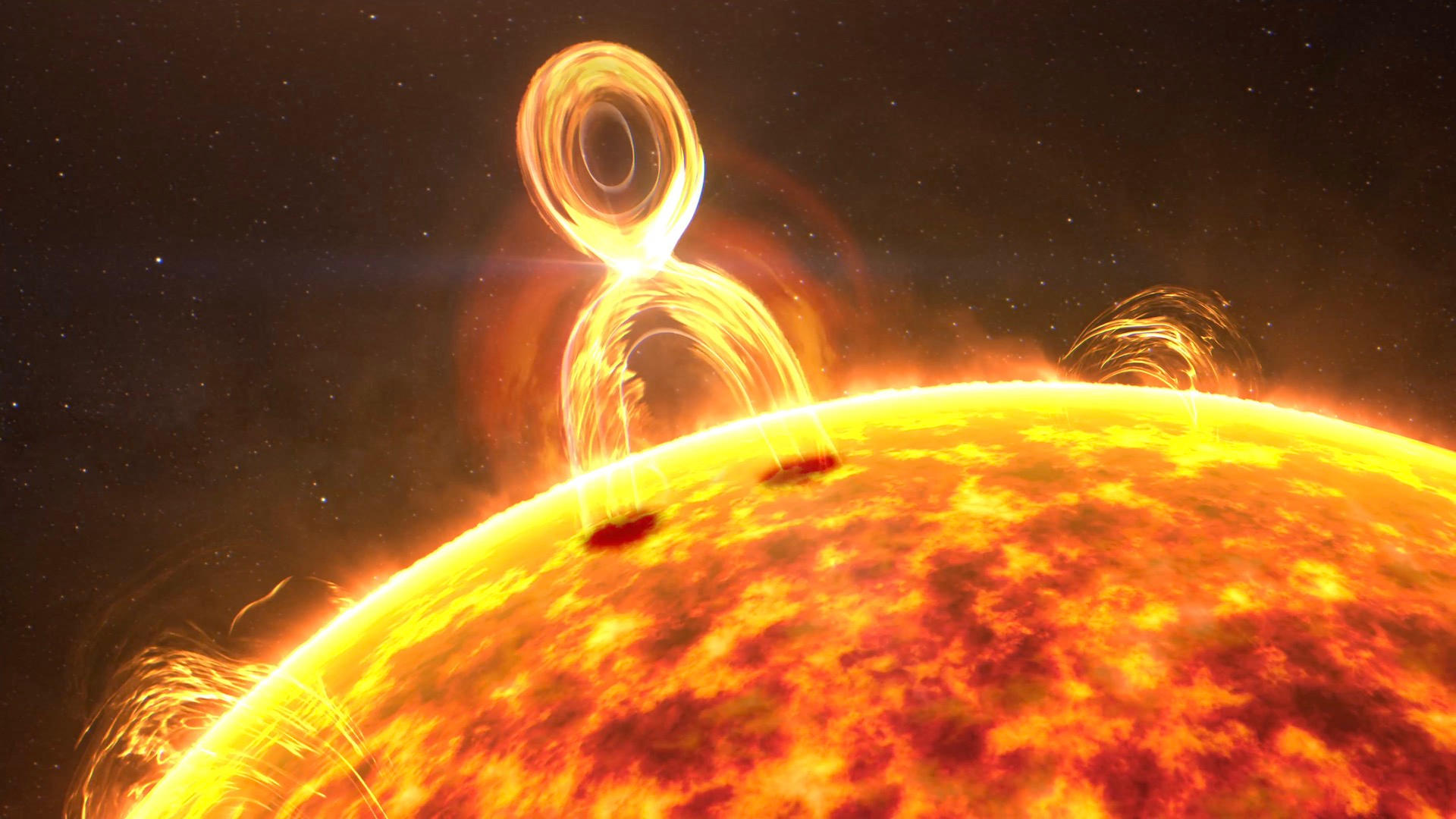
Captura de pantalla del Laboratorio de imágenes conceptuales de la NASA sobre “Reconexión magnética en todo el sistema solar”. La reconexión magnética ocurre cuando los campos magnéticos paralelos, que se encuentran en este caso en las erupciones solares, chocan, se rompen y se realinean. Este proceso produce una explosión de alta energía que catapulta partículas a través del espacio. Crédito: Laboratorio de imágenes conceptuales de la NASA
Los científicos usan potentes láseres para crear erupciones solares en miniatura para estudiar el proceso de reconexión magnética.
Los científicos utilizaron doce rayos láser de alta energía para simular mini erupciones solares con el fin de investigar los mecanismos subyacentes de la reconexión magnética, un fenómeno astronómico fundamental.
Contrariamente a la creencia popular, el universo no está vacío. A pesar de la frase “el vasto vacío del espacio”, el universo está lleno de diversos materiales, como partículas cargadas, gases y rayos cósmicos. Si bien los cuerpos celestes pueden parecer raros, el universo está lleno de actividad.
Uno de esos impulsos de partículas y energía a través del espacio es un fenómeno llamado reconexión magnética. Como sugiere el nombre, la reconexión magnética tiene lugar cuando dos campos magnéticos paralelos, como dos campos magnéticos que viajan en direcciones opuestas, chocan, se rompen y se realinean. Aunque parece inofensivo, está lejos de ser tranquilo.
Este fenómeno se ve en todas partes del universo. En casa, puedes verlos en erupciones solares o en la magnetosfera de la Tierra. Taichi Morita, profesor asociado de la Universidad de Kyushu Facultad de Ciencias de la Ingeniería y primer autor del estudio. “De hecho, la aurora boreal se forma como resultado de la expulsión de partículas cargadas de la reconexión magnética en el campo magnético de la Tierra”.
Sin embargo, aunque ocurre comúnmente, muchos de los mecanismos detrás de este fenómeno son un misterio. Se están realizando estudios, como en[{” attribute=””>NASA’s Magnetospheric Multiscale Mission, where magnetic reconnections are studied in real-time by satellites sent into Earth’s magnetosphere. However, things such as the speed of reconnection or how energy from the magnetic field is converted and distributed to the particles in the plasma remain unexplained.
An alternative to sending satellites into space is to use lasers and artificially generate plasma arcs that produce magnetic reconnections. However, without suitable laser strength, the generated plasma is too small and unstable to study the phenomena accurately.
“One facility that has the required power is Osaka University’s Institute for Laser Engineering and their Gekko XII laser. It’s a massive 12-beam, high-powered laser that can generate plasma stable enough for us to study,” explains Morita. “Studying astrophysical phenomena using high-energy lasers is called ‘laser astrophysics experiments,’ and it has been a developing methodology in recent years.”
In their experiments, reported in Physical Review E, the high-power lasers were used to generate two plasma fields with anti-parallel magnetic fields. The team then focused a low-energy laser into the center of the plasma where the magnetic fields would meet and where magnetic reconnection would theoretically occur.
“We are essentially recreating the dynamics and conditions of a solar flare. Nonetheless, by analyzing how the light from that low-energy laser scatters, we can measure all sorts of parameters from plasma temperature, velocity, ion valence, current, and plasma flow velocity,” continues Morita.
One of their key findings was recording the appearance and disappearance of electrical currents where the magnetic fields met, indicating magnetic reconnection. Additionally, they were able to collect data on the acceleration and heating of the plasma.
The team plans on continuing their analysis and hopes that these types of ‘laser astrophysics experiments’ will be more readily used as an alternative or complementary way to investigate astrophysical phenomena.
“This method can be used to study all sorts of things like astrophysical shockwaves, cosmic-ray acceleration, and magnetic turbulence. Many of these phenomena can damage and disrupt electrical devices and the human body,” concludes Morita. “So, if we ever want to be a spacefaring race, we must work to understand these common cosmic events.”
Reference: “Detection of current-sheet and bipolar ion flows in a self-generated antiparallel magnetic field of laser-produced plasmas for magnetic reconnection research” by T. Morita, T. Kojima, S. Matsuo, S. Matsukiyo, S. Isayama, R. Yamazaki, S. J. Tanaka, K. Aihara, Y. Sato, J. Shiota, Y. Pan, K. Tomita, T. Takezaki, Y. Kuramitsu, K. Sakai, S. Egashira, H. Ishihara, O. Kuramoto, Y. Matsumoto, K. Maeda and Y. Sakawa, 10 November 2022, Physical Review E.
DOI: 10.1103/PhysRevE.106.055207
The study was funded by the Japan Society for the Promotion of Science.

“Amante de los viajes. Pionero de Twitter. Ávido gurú de la televisión. Aficionado a Internet galardonado”.

